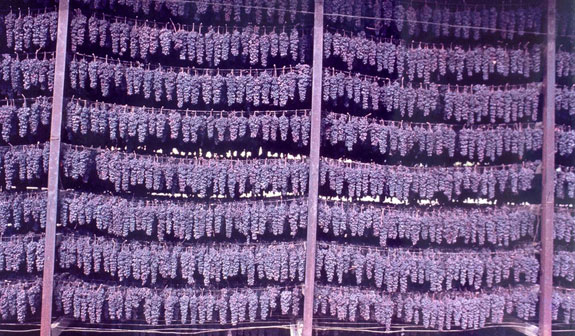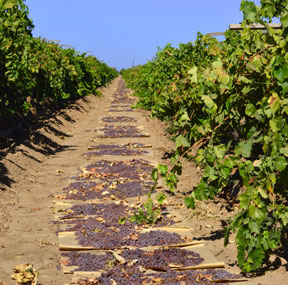Currants
By the word ‘currant’ we refer to the dried berries of all grape varieties. Since ancient times, an important part of viticulture in Messinia was devoted to the production of currants, which along with other dried products held a special place in the diet of our ancestors. The black Corinth grape, which produces small black berries, is cultivated in the northern and southern parts of the Peloponnese and the Ionian Islands.

By the word ‘currant’ we refer to the dried berries of all grape varieties. Since ancient times, an important part of viticulture in Messinia was devoted to the production of currants, which along with other dried products held a special place in the diet of our ancestors. The black Corinth grape, which produces small black berries, is cultivated in the northern and southern parts of the Peloponnese and the Ionian Islands.
Currants are the dried berries of certain vine varieties such as the black Corinth grape and the Sultana grape variety. The entire history of the Peloponnese, Crete and the wider Mediterranean region has been influenced by the cultivation of the vine. Mythology, painting, sculpture, poetry, customs and tradition, dietary habits, trade, medicine and religion are all marked by the vine. Ancient Greek writers such as Herodotus, Plato and Aristotle frequently referred to currants in their works, produced since antiquity and known as “astafides” or “stafylides” or “stafides”. Aristotle describes currants as incomplete grapes with small berries either seedless or with a tiny seed.
Viticulture has a significant place in the economy of Messinia. A large part of grape production was devoted to the production of currants, which along other dried products, held a special place in the diet of our ancestors.
The Corinthian currant is cultivated in Greece since the Homeric times, while written references on its trade exist from the 12th century. In the early 19th century, during the Greek Revolution, the large vineyards of the Peloponnese were destroyed by the Ottomans, mainly under the rule of Ibrahim Pasha. Recovery occured in the late 19th century, due to the destruction of the vineyards in France.
The Sultana variety is of Asian origin and comes from the “Sultanie” region in North Iran. From there, in the 12th century BC, it was introduced and cultivated in the valley of the Hermes (Gediz) river (Magnesia of Asia Minor). Its cultivation then spread to the Smyrna (Izmir) region and the rest of the Ionian coast. Sultanas were introduced from Smyrna to the Nafplion area in 1838 and then spread to the Argolis region and Crete in 1901.
In the late 19th century, the Corinthian currant exports accounted for up to 75% of the total of Greek exports, which on the eve of the Balkan Wars contributed towards the reconstruction of the Modern Greek state, the creation of the first industrial nuclei and the urban transformation of the Greek society. Vineyards were developed in Kyparissia, Filiatra, Gargalianoi, Pylos, Messini and other areas in the northern and southern parts of Messinia. After the Second World War, a company was founded in Kalamata aiming at the export of local products such as olives and olive oil. In the 1950’s its founder, Christos Papadimitriou, focused on the export of Corinthian currants to the markets of Great Britain, the Netherlands and Germany and managed to establish both the company and the area of Messinia as the main national exporter of the product. Currants are internationally considered as a unique product, given the fact that more than 80% is produced in Greece and is a dual-use variety since it can be dried or used for winemaking.
Harvest is followed by the process of sun-drying the currants on threshing floors. The sweet and seedless grape is sun-dried for 15 days in August. They are then packaged in modern packaging units of Messinia and sent to domestic and international markets.
The process of standardization and packaging currants begins once the producers deliver the dried product to the processing plant. The product is first cleaned from any form of impurities by vacuuming. At the same processing line the product is sorted according to size (small, medium, ungraded) and then washed with fresh water in washing machines with sieve trays that retain heavier foreign material, mainly stones. The currants are then passed through a trimmer that cuts their stems. Empty raisings and other foreign material are removed by using laser technology. Metal detector systems identify and reject any metal particles. After packaging and weighing, metal control machines ensure the excellent quality of the final product. The last stage of the process is to fumigate the currants in chambers in order to control insects and other microorganisms.
She/he shrivelled like a grape (about someone who is worn out)
The black currant vineyard shrivels you (trials and tribulations cause suffering)
On Saint Marina’s day the grape berry, on Saint Elias’s day the grape and on the Feast of the Assumption of the Blessed Virgin wear a scarf (there is a time for everything)

Weather conditions, such as frost, hail, rain, heat and wind, hinder the natural ripening of currants and reduce production. Common diseases that afflict currant production include downy mildew, grape phylloxera and powdery mildew. Production can also be afflicted by animals like foxes, birds and badgers.
Preventative measures such as fencing off the vineyard with stones or reeds, hanging coloured ribbons or cowbells, and placing scarecrows can effectively deter animal pests and protect production.